
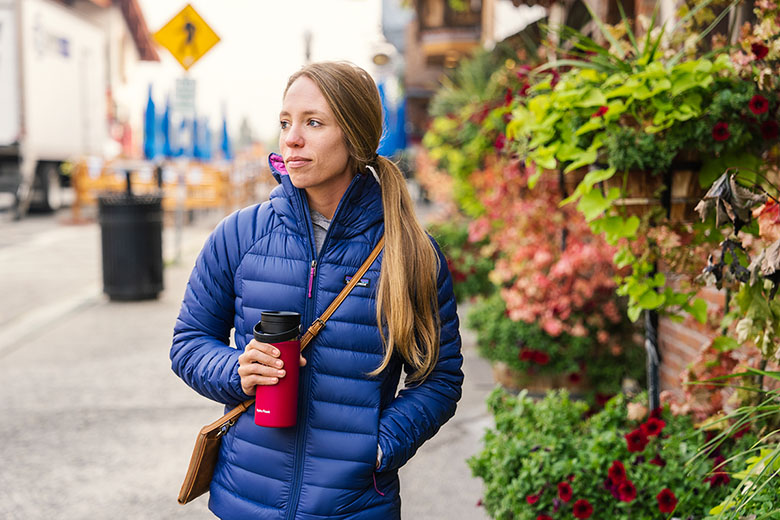
Price: $329
Weight: 12.1 oz.
Fill: 4 oz. of 800-fill down
What we like: Excellent versatility and comfort in a light and sustainably built package.
What we don’t: Expensive and a little underbuilt for frequent backcountry use.
See the Women's Down Sweater Hoody See the Men's Down Sweater Hoody
Patagonia’s Down Sweater is legendary in the down jacket world, combining impressive versatility in a lightweight and good-looking package. Patagonia updated the popular design for fall 2022 with a new shell made from recycled fishing nets, lower weight, drop-in pockets for added storage, and small changes to the collar and baffle design. After wearing the retooled women’s hoody around town and bringing it on a backpacking trip in Washington’s Glacier Peak Wilderness, I’m happy to report that the latest model is the best iteration yet. It’s pricey at $329 and a little underbuilt for demanding backcountry use, but the well-rounded build makes it great for everything from wearing casually to pairing under a shell at the ski resort. To see how the Down Sweater stacks up to the competition, see our article on the best women’s down jackets.
With 4 ounces of lofty 800-fill-power down (0.5 oz. more than the past-generation model), the latest women’s Patagonia Down Sweater Hoody offers an impressive amount of warmth for the weight. For comparison, it’s slightly warmer than Arc’teryx’s Cerium Hoody (3.3 oz. of 850-fill down in a women's small) but a little less insulated than midweight alternatives like Patagonia’s own Fitz Roy Down Hoody (4.5 oz. of 800-fill down) and Rab’s Microlight Alpine Down Jacket (5.1 oz. of 700-fill down). In sum, it’s a really versatile level of warmth for both casual and backcountry use in the shoulder seasons and at higher elevations in the summer.
I admittedly run pretty cold, but the Down Sweater Hoody has kept me comfortable in temperatures down to around 40 degrees Fahrenheit with just a light baselayer underneath. For reference, my first outing with the jacket was an early-October backpacking trip into Washington’s Glacier Peak Wilderness, where the days were warm (in the mid 50s to 60s) but the early hours were cold and biting. I dreaded exiting my sleeping bag on a couple cold and windy mornings, but the Down Sweater did a great job fending off the chill while we cooked breakfast and packed up camp. I did need to add a thin midlayer (Patagonia’s R1 Daily Jacket) on a couple recent chilly mornings that dipped into the 30s in Reno, but that’s to be expected from a lightweight piece (midweight jackets are a better match for below-freezing conditions). And worn under a shell, I expect the Down Sweater to be a near-perfect pairing for resort skiing this winter (I’ll report back once ski season kicks off).
The Patagonia Down Sweater Hoody offers decent resistance against light rain and wind, but it wouldn’t be our first choice in truly inclement weather. We’ll start with the good news: The jacket’s shell and lining are both treated with a durable water repellent (DWR) finish, prompting moisture to bead up and roll off the fabric rather than soaking through. Patagonia also included a few helpful protective features, including a windproof shell, cinchable hood, thin storm flap behind the main zipper, and hem drawcord to seal out drafts along the waist.
That said, the Down Sweater is decidedly underbuilt for heavy rain and wind. First and foremost, down has a tendency to clump up and lose its insulating abilities when wet. Some competitors—including Rab’s Microlight Alpine Down Jacket and Mountain Hardwear’s ultralight Ghost Whisperer/2—use hydrophobic down for an added layer of defense, but the Down Sweater’s down fill lacks a water-resistant coating, meaning you’ll want to avoid letting moisture soak through the shell. Additionally, while the shell does a great job fending off light to moderate winds, the stitched baffling does allow strong gusts to sneak through. If the forecast looks questionable, synthetic alternatives like Patagonia’s own Nano Puff or Micro Puff are better options (synthetic fill will continue to insulate if it gets wet). But regardless of insulation type, we always advise packing a waterproof rain jacket or hardshell to throw on in heavy and sustained rainfall.
At 12.1 ounces for the women’s version (2 oz. lighter than its predecessor), the latest Down Sweater Hoody is more competitive than ever in the lightweight down jacket category. For comparison, Arcteryx’s more performance-focused Cerium Hoody checks in a little lighter at 10.2 ounces but is less insulated, while slightly warmer midweight alternatives like Rab’s Microlight Alpine Down Jacket (14.6 oz.) and Patagonia’s Fitz Roy Down Hoody (14.8 oz.) are a couple ounces heavier. All told, the Down Sweater hits a really nice middle ground in terms of warmth for the weight, and I have no qualms about packing it on longer backpacking objectives.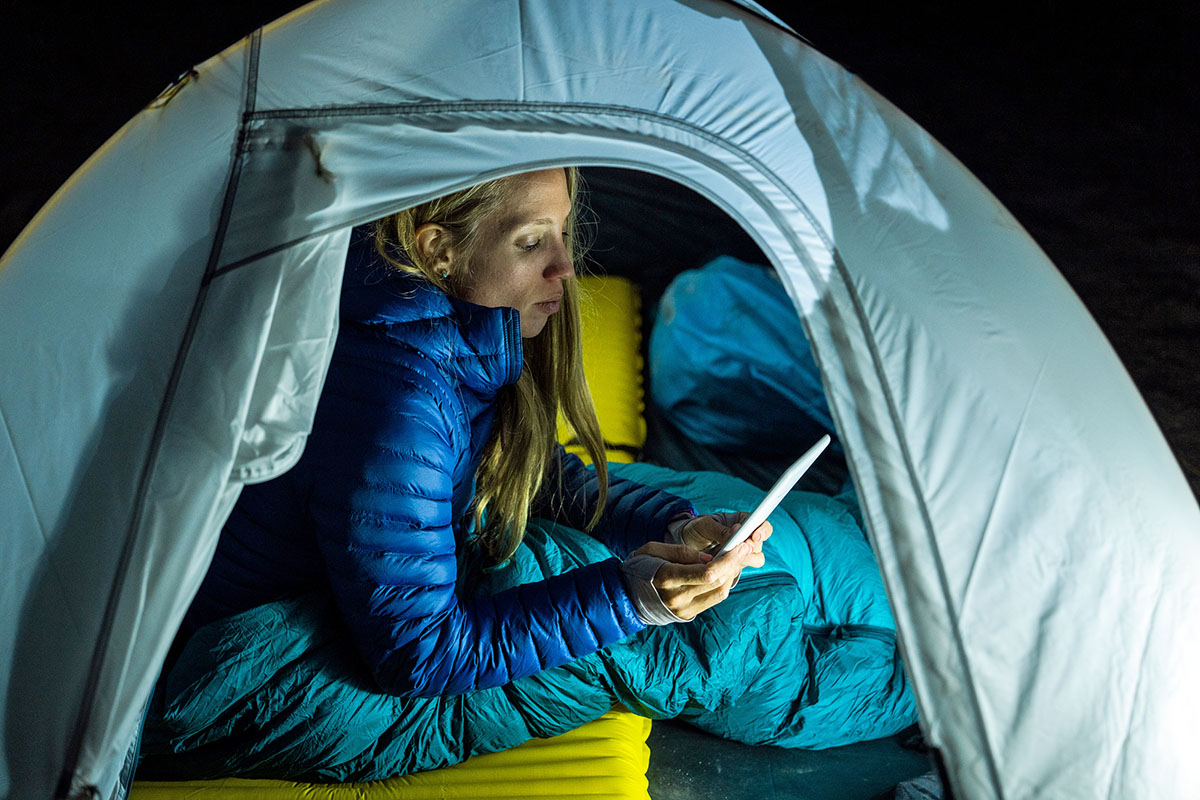
As expected, the Down Sweater Hoody packs down pretty small for storage in a pack or duffel bag—it’s comparable to a 32-ounce Nalgene bottle when compressed. That said, while I appreciate that the internal zippered chest pocket doubles as a stuff sack (with a handy carabiner loop for clipping to a harness or pack), it’s a small space and requires a good deal of force and effort to get the jacket stuffed down. The fabric also has a tendency to snag on the zipper, so you’ll want to be careful to prevent tears. To avoid issues and streamline the process, I often just roll the jacket into its hood or stuff it around other (non-sharp) gear in my pack.
As we’ve come to expect from Patagonia, the Down Sweater Hoody is very well built with a clear attention to detail. The shell is on the thinner end at 20 denier (D) but has held up well to testing thus far, including an accidental encounter with a sharp metal edge while working on my van recently, from which the jacket thankfully emerged tear-free. The rest of the design has a similarly high-quality feel: The shell and interior lining are noticeably soft, the zippers are confidence-inspiring with smooth and consistent movement, and overall fit and finish are top-notch. Patagonia also includes a patch of repair tape, which is a small but thoughtful touch for patching any holes. The Down Sweater is on the pricier end at $329, but overall build quality lines up well with the price—and Patagonia’s generous mail-in repair program adds a nice dose of assurance should you encounter any issues.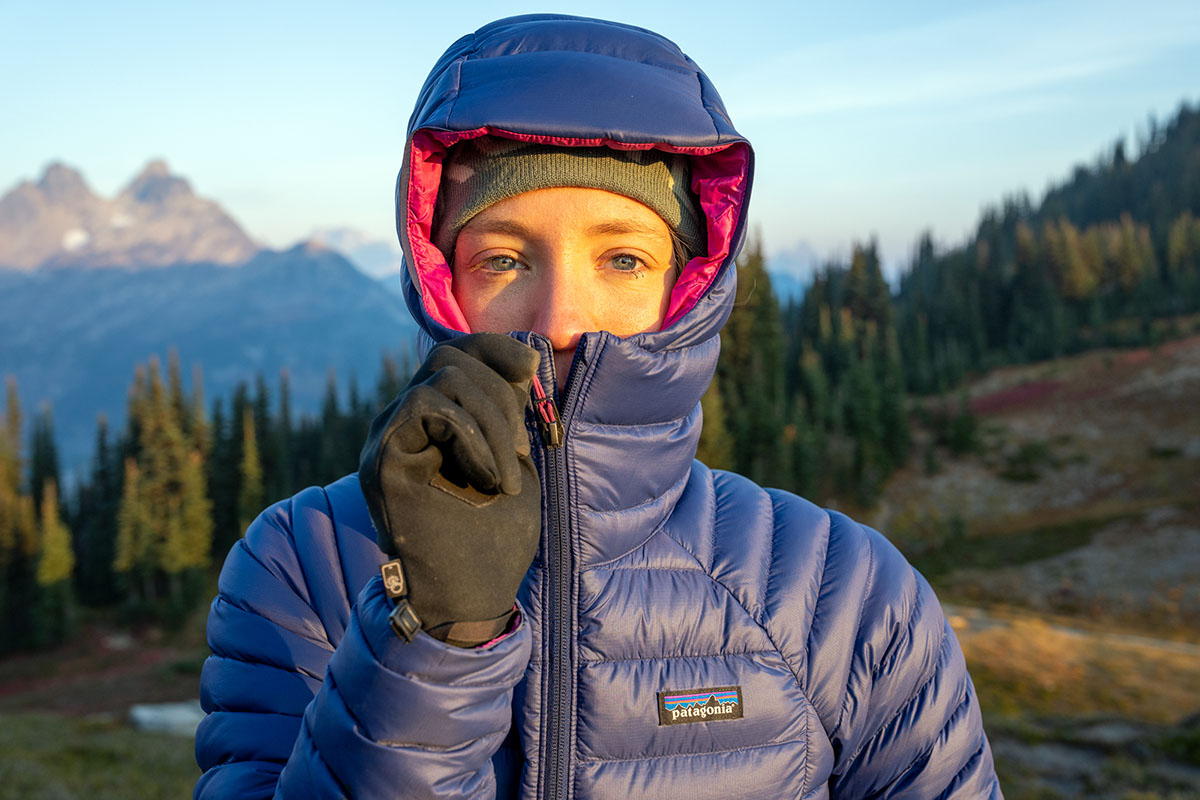
Adding to its versatility, the Down Sweater’s feature set is well executed for both casual and outdoor use. In terms of storage, the two hand pockets are generously sized for warming cold hands with low-profile zippers that contribute to the sleek and streamlined look. You also get an internal zippered chest pocket, which is a little smaller but still easily accommodates a plus-sized smartphone and doubles as the jacket’s stuff sack with a carabiner loop for attaching to a climbing harness or the outside of a pack. With the recent update, Patagonia also added large interior drop-in pockets at each side, which are great for quickly stashing items like a hat and gloves. Interior storage was a little lacking with the past-generation model, but the latest Down Sweater leaves little to be desired from an organizational standpoint.
Rounding out the feature set, the hood is nicely sized and easy to adjust with a single toggle at the back. It’s not listed as helmet-compatible and is too snug to fit over a bulkier ski helmet, but it squeezes nicely over a low-profile climbing lid with minimal impact on range of motion. The hem is also adjustable via an interior drawcord at the right hip, while the simple elastic cuffs do a decent job of sealing out wind and slide smoothly over thin liner gloves (they should work equally well under gauntlet-style mitts). Finally, the main zipper is backed by a thin storm flap with a fabric garage at the top to keep moisture out and prevent hair from getting caught when zipping up.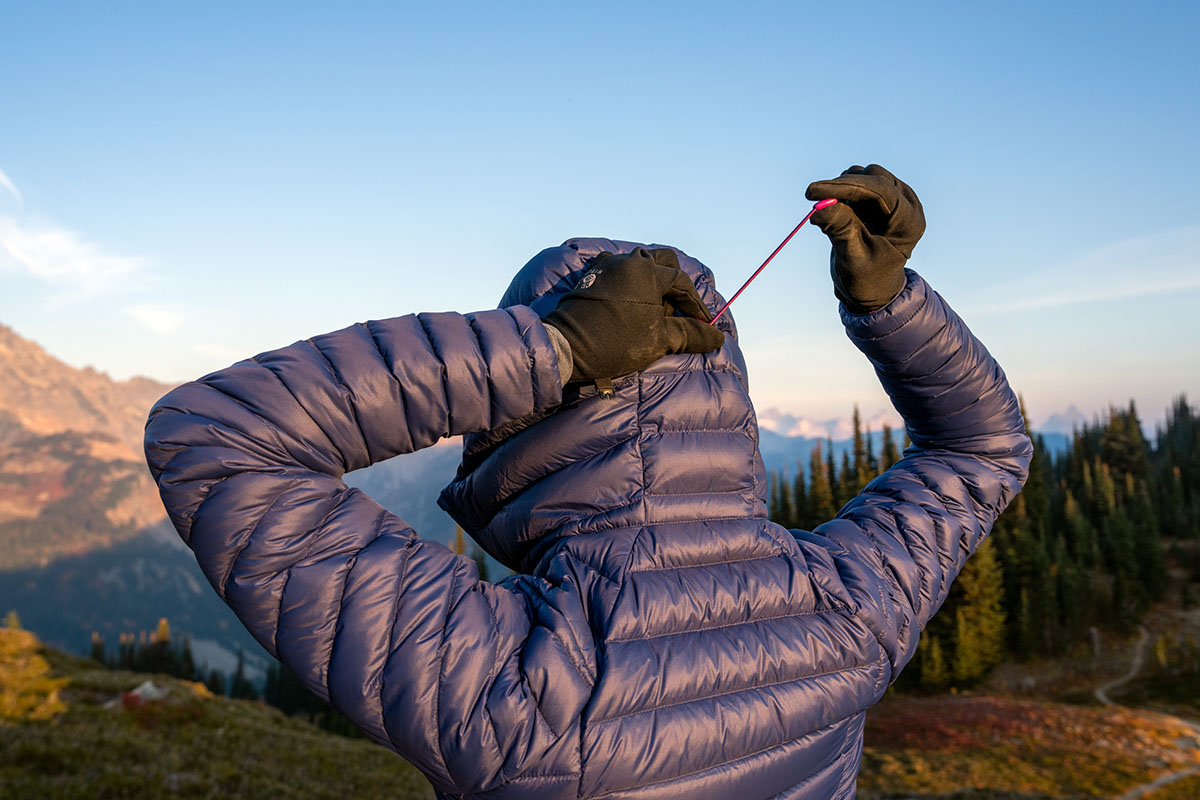
Like the previous version of the Down Sweater, the latest model has a “regular” fit that hits a real sweet spot: trim enough to pair under a shell while still allowing room to layer underneath. For reference, I’m 5’6” and around 135 pounds and found my usual size small to be a near-perfect match. The jacket has a flattering shape that tapers in slightly around the torso, giving it a streamlined and elegant look with no areas that feel overly tight or loose. It’s roomier and less form-fitting than Arc’teryx’s “fitted” Cerium Hoody and other more performance-focused backcountry pieces but still slides nicely under a shell with no noticeable bunching. The soft and supple fabrics also make it easy to move in, and I didn’t experience any mobility issues when setting up camp or reaching overhead during van projects. I do wish the cut were a little longer (center back length is 25 in.) for added coverage when bending over, although this does contribute to the sleek look and barely-there feel.
Patagonia is head and shoulders above much of the competition when it comes to sustainable practices, and the Down Sweater Hoody is a shining example. Specifically, the latest model uses a NetPlus shell that’s made from recycled fishing nets and boasts a PFC-free DWR finish that forgoes the use of harmful perfluorinated chemicals. Finally, the jacket is certified to the Responsible Down Standard, which ensures that the down fill was sourced responsibly with no force-feeding or live-plucking. Patagonia gear certainly doesn’t come cheap—and the Down Sweater is particularly pricey at $329—but the sustainably sourced and eco-friendly materials do help justify the added expense.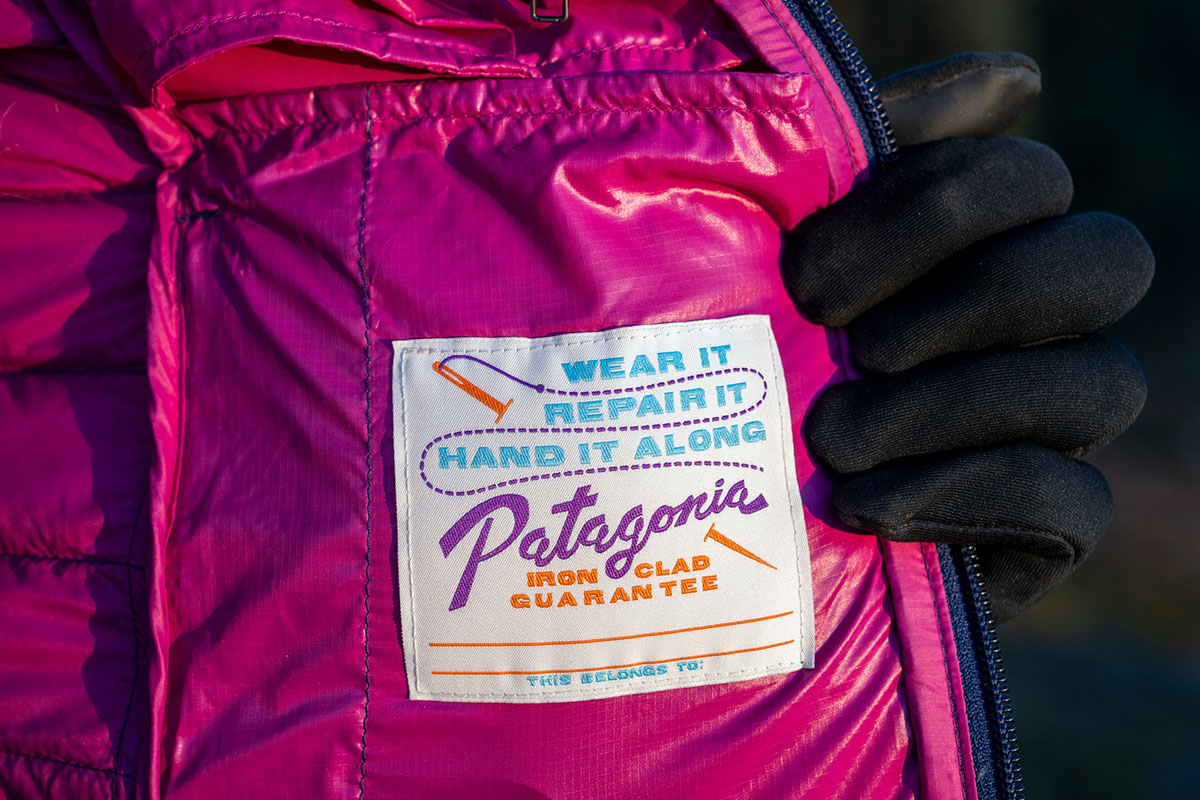
We tested the women’s Down Sweater Hoody for this review, and it’s also sold in a non-hooded version for $50 less. In parsing out the differences, the women's Down Sweater Jacket is slightly lighter at 10.3 ounces and uses a little less down than the hooded model (3.5 oz. vs. 4 for the hoody). Both jackets are sold in men’s models for the same price, with the main differences being weight and colorways. Patagonia also sells the Down Sweater in vest models for men and women, which retail for $229. Rounding out the popular collection, Patagonia offers several options for toddlers and kids, including standard and high-loft jacket variations, fun reversible designs, and vests.

| Jacket | Price | Weight | Fill | Fill Weight | Denier |
|---|---|---|---|---|---|
| Patagonia Down Sweater Hoody | $329 | 12.1 oz. | 800-fill-power down | 4 oz. | 20D |
| Arc'teryx Cerium Hoody | $400 | 10.2 oz. | 850-fill down & Coreloft | 3.3 oz. & 80/100g | 15D |
| Cotopaxi Fuego Down Jacket | $295 | 14 oz. | 800-fill-power down | Unavailable | 20D |
| Rab Microlight Alpine Jacket | $280 | 14.6 oz. | 700-fill-power down | 5.1 oz. | 30D |
| Patagonia Fitz Roy Down Hoody | $399 | 14.8 oz. | 800-fill-power down | 4.5 oz. | 20D |
Patagonia’s Down Sweater Hoody is one of the most well-rounded down jackets on the market: It’s warm for the weight, reasonably light and packable, and transitions nicely between outdoor and casual wear. That said, for strictly backcountry use, we’d step up to Arc’teyx’s more performance-focused Cerium Hoody (formerly the Cerium LT). For around $70 more, the Cerium is a couple ounces lighter and adds a sizable boost in wet-weather protection with synthetic insulation in moisture-prone areas like the shoulders, underarms, cuffs, and collar. The rest of the design uses slightly higher-quality 850-fill down that’s warmer for the weight than the Patagonia's 800-fill variety (although less of it at 3.3 oz.). However, the Cerium’s shell is very thin at 15D (the Down Sweater’s is 20D) to keep weight low, and the “fitted” cut makes it harder to layer underneath. But the Cerium pairs nicely under a shell, and the advantages in weight and weather resistance give it the clear edge for dedicated backcountry use (for more, see our in-depth women's Cerium Hoody review).
Next up is Cotopaxi’s Fuego Hooded Down Jacket, which sticks to a similar recipe as the Down Sweater for $34 less. Like the Patagonia, the Cotopaxi uses premium 800-fill down (bonus: It’s water-resistant) and a 20D shell that’s light but reasonably tough. We also love the trademark styling, which gives the Fuego a very fun and retro look that wears well around town, and the jacket is offered in a whopping 12 colorways at the time of publishing (compared to seven for the Down Sweater). However, the Fuego is around 2 ounces heavier and a small step down in warmth—Cotopaxi doesn’t provide a fill weight, but we found it worked well in temperatures down to the mid to low 40s Fahrenheit with just a light baselayer underneath. The most discernible difference is material quality: The Fuego has a noticeably plasticky and slippery feel compared to the smooth and cozy Patagonia. It certainly hits a nice balance of casual appeal and value, but we consider the Down Sweater the more premium and well-built piece.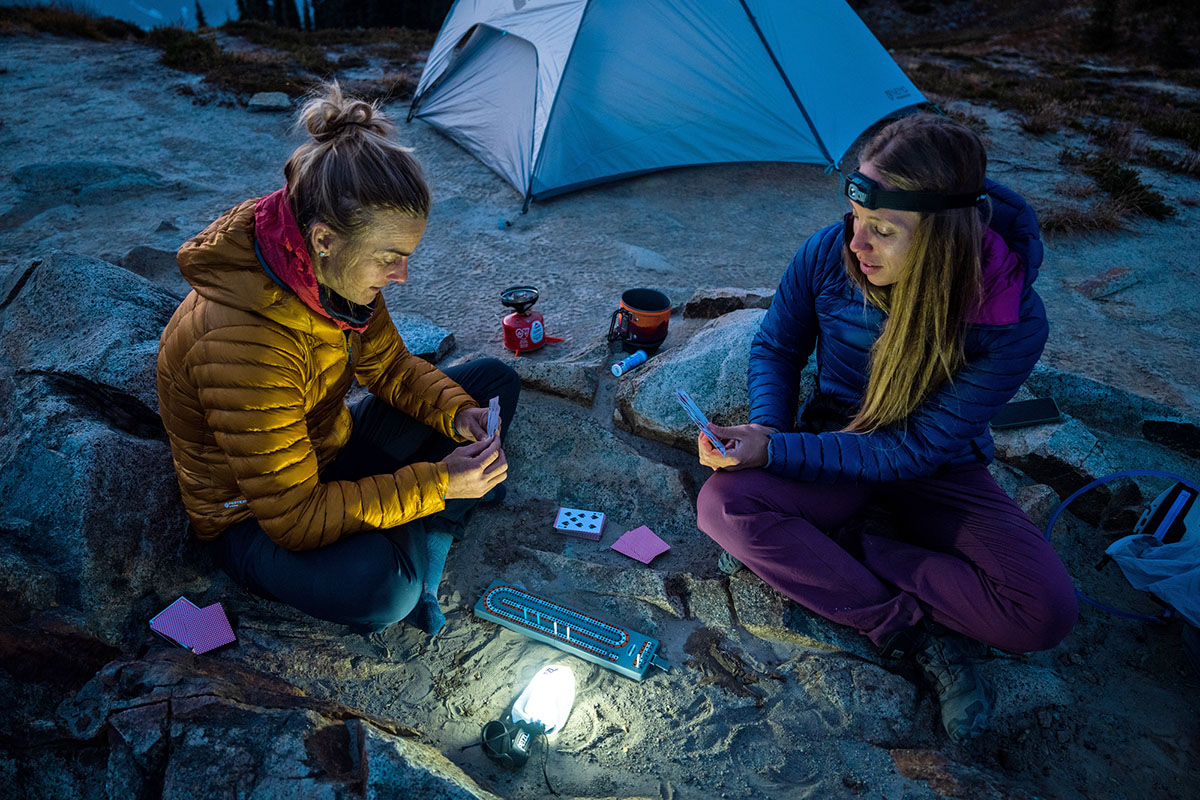
For those who live in notoriously wet climates like the Pacific Northwest, it’s worth considering a more weather-ready alternative like Rab’s Microlight Alpine Down Jacket. Like most of Rab’s down jackets, the Microlight is built to handle wind and light moisture with a tough 30D Pertex Quantum shell, DWR coating, hydrophobic down, and water-resistant YKK zippers on the hand pockets. We also like the rigid structure of the brimmed hood, which has a hardshell-like feel and offers great all-around coverage and protection. The Rab uses lower-quality 700-fill down but more of it at 5.1 ounces, offering a modest bump in warmth over the Down Sweater at just 2.5 ounces heavier. The slim fit means you can’t layer much underneath—the Patagonia wins out in terms of everyday appeal—but the Microlight Alpine is the more well-rounded backcountry piece for around $50 less.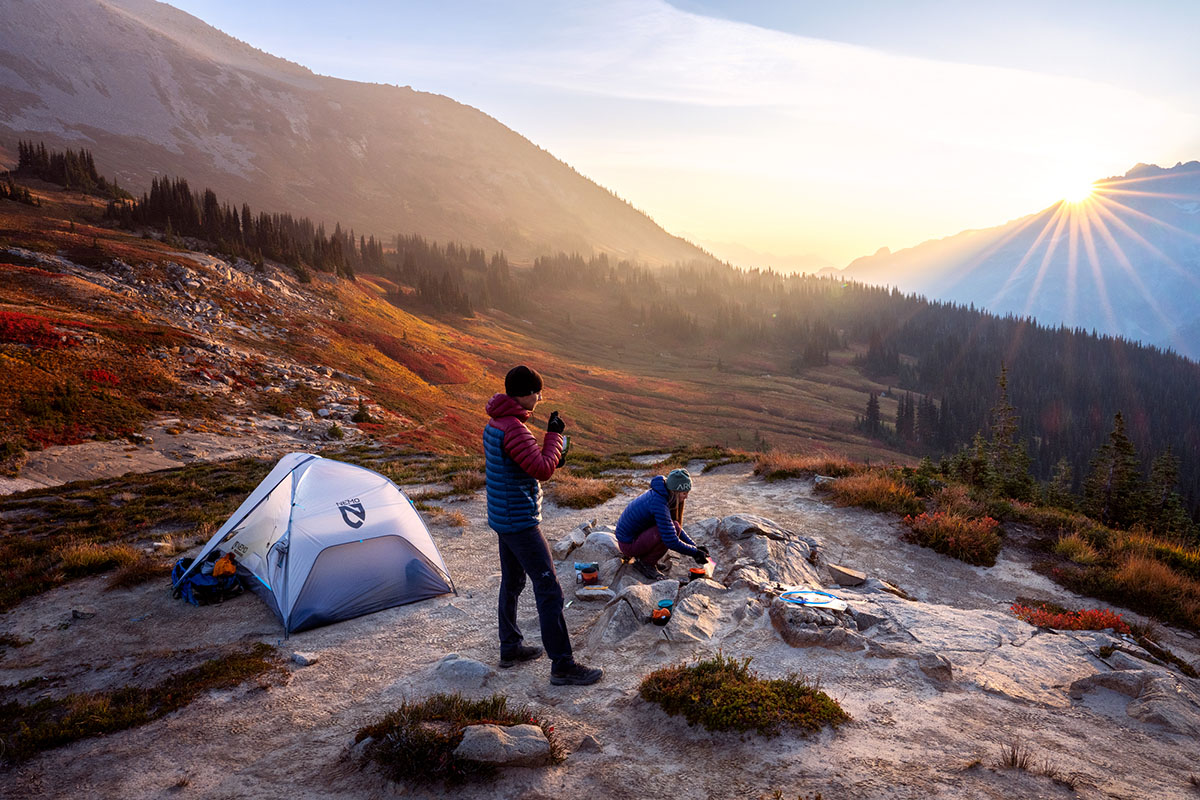
Last but not least is Patagonia’s midweight Fitz Roy Down Hoody, which offers a step up in warmth with an additional 0.5 ounces of 800-fill down for $70 more than the Down Sweater. Other advantages include a more wind-resistant Pertex Quantum shell (also 20D) and alpine helmet-compatible hood with a lofty draft collar for sealing in warmth. The Fits Roy is expectedly heavier at 14.8 ounces, but it offers excellent warmth for the weight and is a great match for speedy winter missions when every ounce counts. The Down Sweater wins out in versatility with a lower-profile look and feel (the Fitz Roy is too bulky to be worn as a midlayer), but the Fitz Roy’s sleeping bag-like loft and coziness are hard to beat for technical use in cold weather.